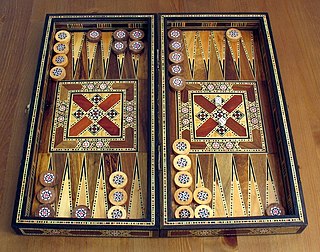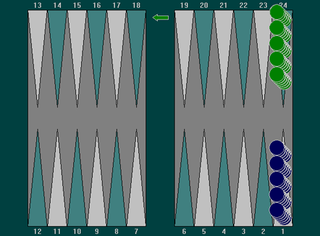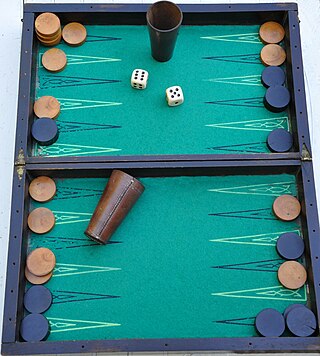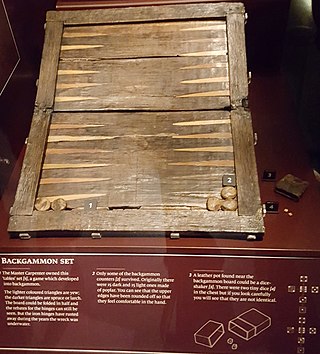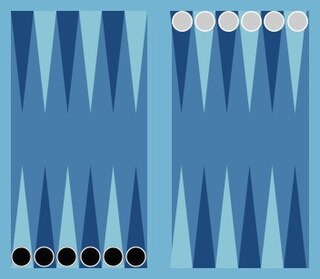Rules
The earliest accounts of the rules of verquere are from the beginning of the 18th century, in French, [3] Swedish, [4] and German publications. [5] [6] The first English account is in a book from 1721. [7]
The equipment

Verquere is played on a rectangular tables board with twelve triangular fields, so called points, along each long side. Each group of six points forms a quarter. One player has fifteen black men and the other player fifteen white men. The players place all fifteen men on the far right point on the opposite side of the board. This point is called the player's home. The main objective of the game is to move the men anticlockwise around the board and be the first to bear the men off.
Moving the men
The players take turns rolling two dice. A player who, for example, rolls five 5-3 moves one man five points forward and another three points forward. The player may also move the same man eight points forward, but the man must then make a touchdown on either the third or fifth point from the start. If a player cannot move a man for one or both dice, he must give up that part of the roll. If he can move either of the two numbers but not both, he must move the larger one.
If both dice show the same number, the player has rolled a double. Each die in a double counts twice, which means that the player must move four times for the number of eyes shown. If a player cannot move four times, he must move as many times as possible.
Hitting men
A single man on a point is called a blot. If a player has a blot and one of the opponent's men lands or makes a touchdown on that point, the blot is hit. The player must pick it up from the board—place it on the bar, in modern terminology—and re-enter it in his first quarter. The man is re-entered on the point in the player's first quarter that has the same number as the number of eyes on the die. A player who, for example, rolls 4-2 may re-enter a man on either the fourth or second point. A player may not move any other man on the board as long as he has one or more men on the bar that must be re-entered. If a man is re-entered on a point where the opponent has a blot, the blot is hit and must be re-entered by the opponent.
Closed points
Two or more men form a closed point, which under normal circumstances is protected. A closed point is called "ein Band" in German [5] [6] and "ett band" in Swedish, [4] which both mean a band or a string in English. The French term is "une case", [3] which means a hut or a box in English. A player may not land, make a touchdown, or re-enter a man on a point that is closed by the opponent.
On the opposite side of the board, the players may only close the point on the far left. That point is called the player's head. On their own side of the board, the players may close any point.
Jean and Juncker


A player may not re-enter men on points where he has men of his own or points that are closed by the opponent. If the number of men on the bar and the number of points that are occupied by the player's own men exceed six, the player can never re-enter all his men. The player has become Jean and loses a double game. [4] [6] The English text says that the player has become John. [7]
If a player has fewer men on the bar than required for Jean but more men than there are empty points and blots of the opponent in his first quarter, the player cannot re-enter all men before the opponent vacates some of his closed points in that quarter. The blocked player has become Juncker. He has not lost the game, but he must pass his turn until the opponent has made enough room for the player to re-enter all men on the bar.
Bearing men off
A player who has rounded up all his men in his fourth and last quarter may bear the men off to an imaginary twenty-fifth point. If a die shows more eyes than are required to move the backmost man to the twenty-fifth point, the player may still bear it off. However, the player must always use as many of the dice's eyes as possible. If a player, for example, has one man on his second last point and two men on his last point and rolls 2-1, he must bear one man off from each point and leave a blot on the last point. The player may not move the man on the second last point to the last point and then bear it off, as he in the latter case uses two eyes and in the former case three eyes. A player who bears off his last man wins the game.
All men on the last point
A player who manages to place all his men on the last (twenty-fourth) point does not have to bear the men off, but immediately wins a double game. [4] [5] [6] This rule is not mentioned in the French and the English texts and seems to be a later addition to the game. [3] [7]
Five blots and five closed points
Before a game, the players could agree to play with "five blots and five closed points". [4] [5] [6] "Five blots" means that the players may not close any point until they have moved five blots from their home. "Five closed points" means that closed points become vulnerable if a player builds a prime with more than five consecutive closed points. If the opponent lands, makes a touchdown, or re-enters a man on a closed point in such a prime, all the men on that point are hit and must be re-entered by the player. These optional rules are not mentioned in the French and English texts. [3] [7]


